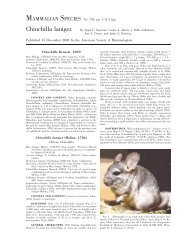Brugia Malayi - Clark Science Center - Smith College
Brugia Malayi - Clark Science Center - Smith College
Brugia Malayi - Clark Science Center - Smith College
You also want an ePaper? Increase the reach of your titles
YUMPU automatically turns print PDFs into web optimized ePapers that Google loves.
Effects of Anxiety on Non-sexual Affiliative Behavior in M. pennsylvanicus<br />
Ellen Gunzel<br />
During the summer we conducted tests on microtus pennsylvanicus, which aim to examine the role of anxiety in the expression of<br />
pro-social behavior and partner preference formation. One hypothesis regarding the role of oxytocin in pro-social interactions is<br />
that it functions to reduce social anxiety. This is consistent with our current understanding of meadow vole social behavior and its<br />
non-reliance on nucleus accumbens dopamine and reward signaling. 1 However, no specific tests, which relate anxiety behavior and<br />
social behavior, have been conducted. We plan to characterize base-line anxiety measures together with social behavior in voles<br />
housed in day lengths that promote social behavior (short day lengths; SDs) and voles housed in summer-like day lengths (long<br />
days; LDs) when voles are markedly less social.<br />
Adding diazepam, at different dosages, will allow for the isolation of the effects of anxiety during the partner preference<br />
tests. By comparing how social behavior is altered by diazepam administration (versus saline control), the role of anxiety in social<br />
behavior will be clarified. “Diazepam will be administered during three behaviorial tests of anxiety as well, in order to confirm its<br />
effectiveness in voles.”<br />
This study aims to determine the relationships between day length (10h vs 14h), anxiety (measured by light/dark box, elevated<br />
plus maze, and open field tests), and social behavior (measured by huddling time in partner preference tests), with a focus on<br />
same-sex affiliative behavior. Comparison between groups of long-day and short-day photoperiods will determine if anxiety<br />
differs among different seasons. It is expected that partner preference is more likely to develop with a co-housed female during<br />
the non-breeding season (SD condition). Individual differences in social contact during partner preference test and results from<br />
anxiety tests (open field, elevated plus maze, light/dark box) will be examined to determine if anxiety is related to sociality on an<br />
individual basis. (Supported by the Schultz Foundation)<br />
Advisor: Annaliese Beery<br />
Vole grouping:<br />
# voles (pairs) Day length Dosage<br />
20-24 (10-12) LD Saline<br />
20-24 (10-12) LD Dose 1<br />
20-24 (10-12) LD Dose 2<br />
20-24 (10-12) SD Saline<br />
20-24 (10-12) SD Dose 1<br />
20-24 (10-12) SD Dose 2<br />
References:<br />
1<br />
Beery AK, Zucker I (2010) Oxytocin and same-sex social behavior in female meadow voles. Neurosci 169: 665-673.<br />
2012<br />
149

















